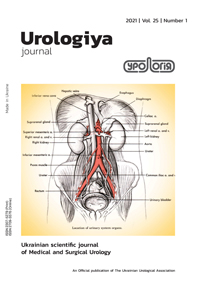The method of identification of the female prostate gland with taking into attention types of its anatomical location
DOI:
https://doi.org/10.26641/2307-5279.25.1.2021.231365Abstract
Aim. To improve the method of identification of the female prostate gland, taking into account the types of its anatomical location.
Materials and methods. Was performed sexological, gynecological and urological examination of 36 sexually active women aged 24-42 years, average age 32.1 ± 3.4 years. For all patients was performed an ultrasonographic study with doppler examination of the vessels of the paraurethral zone. Before the examination was performed catheterization of the bladder and insertion of elastic balloon into the vagina (50 ml) filled with gel, also a lubricant was used on the clitoral zone.
Results. It was established that the accumulation of paraurethral tissue in the area of †the anterior part of the urethra, with the volume of accumulation of the tissue of the gland in 7.26 ± 1.3 cm3, and the highest level of serum PSA 0.79 ± 0.15 ng / ml is most common, and was diagnosted in 70% of the examined women (n = 18). The distribution of prostatic tissue in the region of the posterior urethral wall, with tissue volume 2.13 ± 0.02 cm3, and the serum PSA level of 0.309 ± 0.013 ng / ml, was diagnosed in 15% of women (n = 9). The location of the prostate gland throughout the length of the female urethra, diffuse type, with a tissue volume of 4.49 ± 0.60 cc and a PSA level of 0.299 ± 0.295 ng / ml was detected in 9% of cases (n = 6). The fourth type of female prostate gland - with a lack of visualization, but with the definition of PSA, with a stingy value of 0.016 ± 0.014 ng /ml occurred in 6% of the examined women (n = 3).
Conclusions. The diagnostic ultrasound method with Doppler allows you to clearly visualize in detail the various types of localization of the female prostate gland (front, back, diffuse), and also to constrain the absence of this anatomical structure in comparison with the level of serum PSA.
References
Zaviacic M., Zaviacic T., Ablin R. J., Breza J., Holoman J. The human female prostate: history, func-tional morphology implications. Sexology. 2001. Vol. 11. P. 44–49.
De Graaf R. De mulierum organis generationi in-servientibus. Tractatus novus demonstrans tamhomi-nes et animalia caetera omnia, quae viviparadicuntur, haud minus quam viviparadicuntur, haud minus quam vivipara ab ovo originem ducere. Leyden, 1672.
Skene A.J.C. The anatomy and pathology of two important glands of the female urethra. Amer J Obstetr Diss Women Child. 1880. Vol. 13: P. 265–270.
Virchow R. Celluar Pathology. 1857. P. 516–522.
Huffman J.W. The detailed anatomy of the para-urethral ducts in the adult human female. Am J Obstet Gynecology. 1948. Vol. 55. P. 86–101.
Grafenberg E. The role of the urethra in female orgasm. Int J Sexology. 1950. Vol. 3. P. 145–148.
Addiego F., Belzer E. G., Commoli J. et al. Fe-male ejaculation: a case study. J Sex Research. 1981. Vol. 17. P. 13–21.
Perry J., Whipple B. Pelvic muscle strength of fe-male ejaculators: evidance in support of a new theory of orgasm. J. Sex. Res. 1981. Vol. 17. P. 22–39.
Hines T.M. The G spot: a modern gynecologic myth. Amer J Obstet Gynecol. 2001. Vol. 185, No. 2. P. 359–362.
Zaviacic M., Zaviacic T., Ablin R., Breza J., Ho-loman J. Ultrastructure of the normal adult human female prostate gland (Skene’s gland). Anat Embryology. 2000. Vol. 201. P. 51–61.
Rubio Casillas A., Rodriguez Quintero C.M. The female prostate: the end of the controversy. International Society for Sexual Medicine. Newsbulletin. 2009. Vol. 30. P. 7.
Taboga S.R., Goes R.M., Zanetoni C., Santos F.C.A. Ultrastructural characterization of the secretory cells in the prostate: a comparative study between the male and female organs. Acta Microscopia. 2001. Vol. 3. P. 205–206.
Billis A., Reis L.O., Ferreira F.T. et al. Female urethral carcinoma: evidences to origin from Skene’s glands. Urologic Oncology: Seminars and Original Investigations. 2011. Vol. 29. P. 218–223.
Спосіб візуалізації жіночої передміхурової залози: пат. № 110397 UA: МПК (2016.01): A61B 8/00. № u 201603068; заявл. 25.03.2016; опуб. 10.10.2016. Бюл. № 19. 6 с.
Downloads
Published
Issue
Section
License
Стаття повинна мати візу керівника та офіційне направлення від установи, з якої виходить стаття (з круглою печаткою), і вказівкою, чи є стаття дисертаційною, а також у довільній формі на окремому аркуші - відомості про авторів (прізвище, ім’я, по батькові, посада, вчений ступінь, місце роботи, адреса, контактні телефони, E-mail).
Стаття повина бути підписана всіма авторами, які укладають з редакцією договір пропередачу авторських прав (заповнюється на кожного автора окремо з оригінальним підписом). За таких умов редакція має право на її публікацію та розміщення на сайті видавництва.

